Golf In Australia
by Matt Cohn
Australia represented a lot of things to me. It was my first time living in a great international city like Melbourne, and a time when I found my closest friends yet. I learned so much about myself, about the world, and about other people. And I had more fun than I could ever write about!

Melbourne’s central business district.
I also saw some of the greatest golf courses in the world – not just on the Sandbelt, but all around Melbourne, and Sydney as well. I did well, I think. Australia has four golf courses in the World’s Top 100, and I played three of them. In total, I played eighteen courses, walked one, and set foot on seven more. I played five of the country’s top 10 and saw the clubhouse at eight of them.
I need to thank a bunch of GCA’ers one more time, because without them…well, those experiences simply wouldn’t have happened. And besides that, it was so good to have a group of friends whom I enjoyed being with, and who cared how I was going. So, thank you one last time to…Brian Walshe and his family, Shane Gurnett and his family, Justin Ryan, Chris Kane, John K. (the American), Mike Clayton, Michael Cocking, Paul Daley, Nic Phipps, Ken Titcume, and George Blunt. Also, some non-GCA’ers…Jason Perry, David Burton, Gregg Chapple, and Paul Rak. Thank you so much!
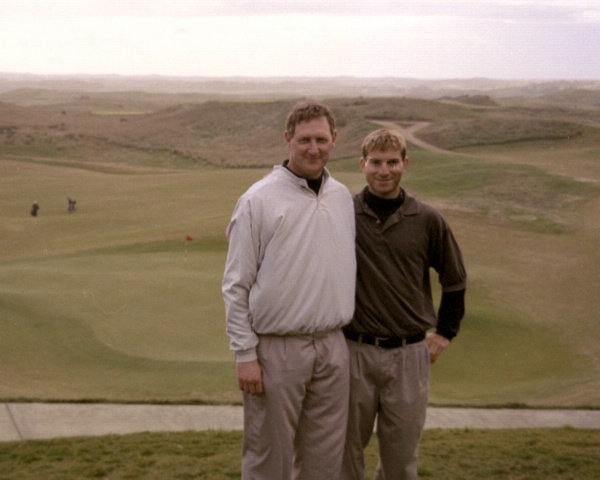
Brian and me at National Golf Club.
My overall impression was that there is a lot that is right with the game in Melbourne. For the first time, I saw course after course that embodied what we all talk about on GCA. It was so different than what I grew up on in Southern California. We write on GCA about options, thoughtful green complexes, fast-and-firm, naturalness, playability for all players… I saw them all in Australia, and happily, not just on the Sandbelt.
Of course, there were three things going on at once. First, I was playing some of the best courses in the world. Second, most were Mackenzie or Mackenzie-influenced. Third, of course, they happened to be in Australia. It’s impossible to completely separate those three factors.
The combination of the three, however, is superlative. Golf has developed well around Melbourne. There were some really positive early influences, particularly Alister Mackenzie. Some undesirable influences – electric carts, overwatering, and 5-hour-rounds – haven’t taken strong hold. The land, weather and ground conditions are all conducive to fantastic golf holes and top playing conditions.
By the way, I will write about Melbourne and the Sandbelt, but it all applies to New South Wales and Newcastle too, because as Mackenzie and Apperly designs, respectively, they exist in very much the same spirit.
So what actually makes these places so great? Here are some ideas; I’ll start at the greens, and work my way back, and then talk about the holes and courses in total.
Greens:
The greens I saw had bolder and better contours than what I’m used to in America. Even new courses and country courses had wonderful, sloping, rolling greens that make the greens on a lot of courses in America seem flat and disinteresting.
It’s hard, of course, to describe greens with words. Many of you have seen Royal Melbourne and New South Wales on TV. These are greens where one’s work is not done simply by reaching the green in regulation; until the ball is in the hole, there is always some uncertainty. One GCA poster commented on how ‘complex’ the green complexes at RM are, and that is a great word for all of the greens on the Sandbelt and at NSW. They’re not just difficult and interesting; they’re complex and complicated. The greens don’t just have one constant slope, and they certainly don’t have simple flat spots separated by tiers. Handling Sandbelt greens requires substantially more consideration, as well as more talent, than the flatter, more modest greens I’ve become used to in the States. They fulfill the ideal of Pete Dye and others that there ought to be some skill involved in getting the ball in the hole in two shots from 40 feet away.
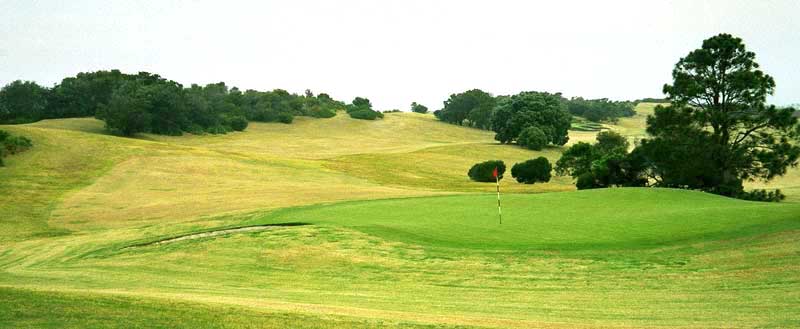
The par-4 9th at New South Wales.
Around the Greens:
There’s no rough! The green surrounds are cut at fairway height, and the ball can really get away. From there, a player might be 40 feet from the hole, with nothing between him and the hole except grass cut at 1/2 inch or less – and have no idea how to get it close! It’s fascinating stuff. Kingston Heath was one course that stood out in this regard. All around those greens, and over them in particular, there were some really devilish shots. Things just get complicated. Given that 40-foot shot, there might be 3 or 4 major features to consider between one’s ball and the hole, and there might be 3 or 4 different ways to play the shot. The first of a few examples from the 2003 Heineken Classic: does anyone remember Nick Faldo left of the green on #15 during one of the rounds? He was about 35 yards from the hole, with nothing but fairway and green to the hole. But because of a few subtle rolls left of the green and the firm, tight fairway grass, he had any number of options available.
Bunkers:
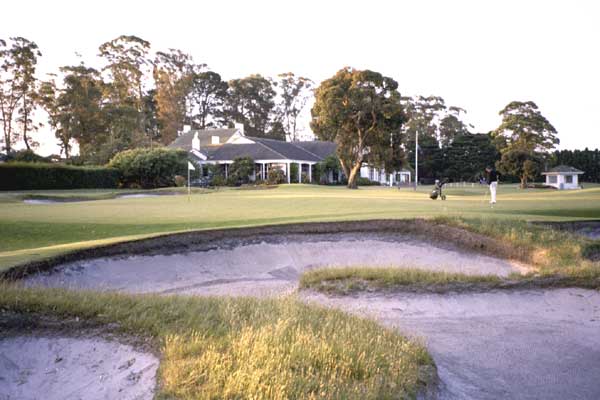
Kingston Heath’s greenside bunkering at #18.
Of course, the Sandbelt is known for its bunkers. The look is amazing, with big faces and sharp edges cut right into the fairways and greens. The sand itself is amazing too – so hard on the faces that one can walk straight up them without making footprints. The bottoms of the bunkers are firm, and it seems like there’s just a layer of dust on top. Long bunker shots aren’t that hard, but short bunker shots take perfect execution to make the ball come out soft. With the bunkers cut right into the greens, one has to do that a lot, and it’s extra-difficult because the ball will never stop on an uphill lie on the face. Remember the bunker shot that Ernie Els played on the last hole of the Heineken? He literally landed the ball a foot over the lip of the bunker, just to get it to stop by the hole. On an American course, his ball would have been on an uphill lie and he would have had much more room over the lip. The shot would have been an easy one!
Trees:
I saw some very instructive things here. RM and KH have beautiful trees that don’t interfere with play – good! Other courses had some real tree issues – bad. Having played most of my golf in the American southwest, I hadn’t learned much about tree issues before going to Melbourne.
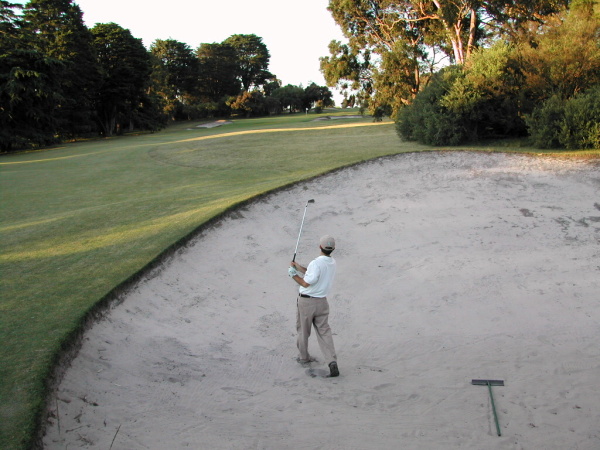
In trouble on #11 at Commonwealth, a tough par-4.
Rough:
There’s no American-style, really thick rough. The rough is thin and inconsistent, to where one loses control, not distance. It’s less predictable and offers more possibilities than hacking out of long thick grass. With the recent drought, the rough during the summer of 2003 was even thinner than usual; it’s hard to remember a player ‘in trouble’ in the rough at the Heineken or ANZ events.
Greens Fees:
I have to mention this just because it’s fun. One can join a top Sandbelt club for less than US$10,000 and pay maybe US$1,000 a year in dues. The Dunes and Thirteenth Beach would both be $60 or $70 in America, but in Australia they are more like US$25. An overseas guest at a top club will pay for the privilege, but at a public course, or as a member’s guest, the fees are unbelievably low from an American point of view. I played Commonwealth one afternoon for US$7.50. I’m not sure how the economics of golf work in Australia, but I certainly enjoyed it.
Ground Conditions:
Fast and firm! The ball bounces, and the greens barely make dents, let alone ballmarks. This is so because it’s agronomically feasible, and because Aussie golfers seem more at ease with hard ground and off-color turf than American golfers. The conditions accentuate the other characteristics – the challenges around the greens, the importance of strategy, the difficulty, and the fun. I never realized just how soft our American greens are until after I came back from Australia. In the States now, I’ll sometimes be on the wrong side of a bunker, or have a downwind approach from a bad angle, think I’ve got no chance, and then realize… ‘Wait, I’m in America! I’m OK!’
On the Aussie courses I played, however, it was a different situation entirely. For example, the 17th hole at Commonwealth is a short par 4. The green is angled away to the back left, the green slopes hard left-to-right, and like several holes at Commonwealth, a bunker crowds the high side of the green. A situation like this is where the firmness of the conditions makes the challenge fundamentally different. In American conditions, from the left side of the fairway, I’d have to carry the ball over the bunker to get it close. In Aussie conditions, from the left side, I simply can’t get it close, because the ball won’t stop. I should have placed my teeshot better. It’s a very different thing.
To keep the example going, imagine that I was in America, I went for the pin, and I hit the ball too far. At worst, it would have held up in short rough behind the green, leaving an easy chip. But at Commonwealth, and at the other courses I played, there is no rough to stop the ball, and the ground is hard. That same shot would have bounded off the back of the green and rolled away until I had very little chance to get up-and-down.
Obviously, such conditions allow the strategy built into these courses to really come into play.
One other note on conditions is that courses didn’t seem too concerned about their ‘peripheral areas’, I think one would call them – between the tee and the fairway, or off in the rough between holes. They might be brown, shaggy, sandy, or inconsistently grassed. I made the comment on a couple of courses that the conditions would get a greenskeeper in America fired – even though the playable areas were maintained perfectly!

The view back down the par-4 #7 at New South Wales.
Challenge-vs.-Playability:
Mackenzie’s ideal that a hole should be challenging for a low marker and playable for everyone is realized around Melbourne, another good idea that has been somewhat perpetuated in modern courses there.
Simplicity and Naturalness:
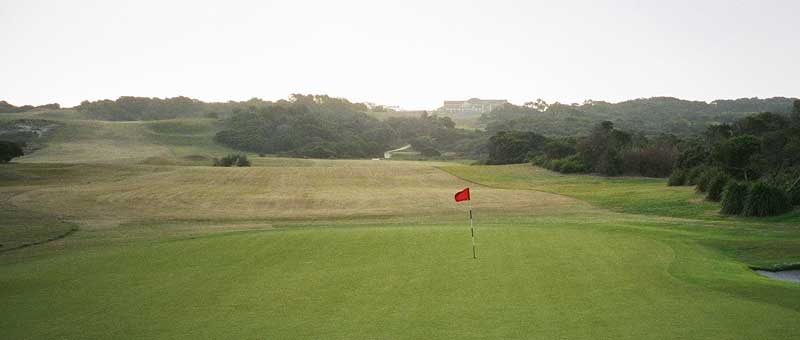
A natural hole on a natural course: #4 at New South Wales.
Of course, the early Sandbelt courses didn’t feature a lot of earthmoving. American courses that used to look natural to me now look so artificial compared to the great Australian layouts. Five months in Australia definitely changed my eye for natural-looking holes. Beyond just the Sandbelt, country courses feature some great holes without a lot of dirt-moving, and even new courses like The Dunes and Thirteenth Beach sit well on the land. I think the early great courses there set an example that’s still being followed more than the corresponding example of America’s classic courses. As well, it’s partly an economic necessity – earthmoving costs simply must be kept low. Finally, the land is so ideal at even the new courses that massive earthmoving is unnecessary.
Is there a trend that maybe the smaller economic scale of the game in Australia has some positive effects?
Fun:
These are great looking courses that offer players engaging challenges, shot after shot. They make you want to jump out of the car and run to the first tee before you even have time to park…they make you want to play golf! Mackenzie first, and other architects who followed, created golf courses that are enjoyable for all sorts of players. Those architects could not have followed a higher ideal.
But it’s strange to break courses down into components like that, because they obviously function as an integrated whole. I think the best way to show how all of those aspects work together is to describe two of my favorite holes in Australia, the ways in which they’re characteristically Australian, and how they are fundamentally different from what I’ve seen in America.
My favorite par-3, and one that nobody talks about much, was #9 at Commonwealth. It’s 128m/140y, and it plays about 10-15 feet uphill. First of all, it’s beautiful, and very Aussie-looking – the gum trees, the bunkering, and the coloration are all particularly Australian.
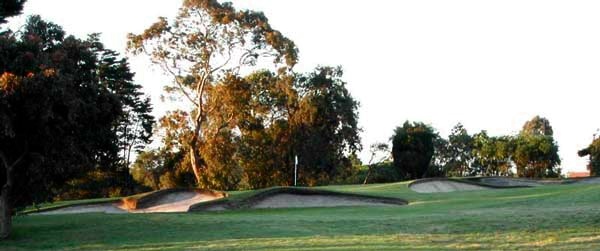
The 9th hole at Commonwealth Golf Club.
It’s a very strategic hole, and a difficult one, which is saying a lot for an 8-iron shot up a hill! Basically, the green is like an elongated triangle pointing to the player’s left, i.e., there are ‘corners’ front-right, middle-left, and back-right. There is sand right, and short-left. The green slopes very strongly off the right bunker all the way off the green to the left. There is a little shelf in the front, between the bunkers, just barely big enough for a pin position.
Depending on the pin position, the hole can play in three completely different ways. A front pin is only a 125 yard shot, but what a difficult one! A tiny miss left or right finds a bunker, and recovery from the right bunker is not possible. Misses short are repelled off the front of the green, and a miss long leaves a fearsome putt. With the pin up, it is a do-or-die shot where one must aim at the pin and make a good swing.
A second pin position is middle-left, approximately on line with the bottom of the gum tree in the photo. Anything left of the hole will bounce off the green, away to the left, but the putt from right of the hole is exceedingly fast.
Finally, the back-right pin presents a totally different scenario. Playing safely left of the pin leaves an uphill putt, but the golfer is tempted to aim at the pin, as he is only about 150 yards away. However, it only takes a small mistake to find the right bunker, from which recovery is impossible and 5 is a possibility.
It’s easy to see from this example how the elements I described above come together – the firmness and speed, the bunker characteristics, the strategy, etc. The continuing variety and challenge offered by this hole of less than 150 yards, and the enjoyment of playing such a hole, are consistent with the characteristics of the best holes on the Sandbelt.
Surely many readers are familiar with some of the great Sandbelt par-4’s. I will pass on describing one of those for now – and on having to choose just one!
For a par-5, I will describe a relatively unknown hole, but one that I respect a great deal, #12 at New South Wales. At around 480m/525y, it is a reachable par-5, and as one would expect of a Mackenzie hole, there are several risks and opportunities players must consider along the way.

The green at #12 at New South Wales.
It’s a great-looking hole again, running eastward over open, rolling terrain, with the Pacific Ocean behind the green in the distance. The hole usually plays crosswind. Just before the 275-yard mark, the fairway drops sharply downward, something like 15 feet – enough to add 30 or 40 yards to a player’s drive. A scary deep bunker sits at the left edge of the fairway just before the drop-off. From the bottom of the hill, around 290-300 yards from the tee, the hole goes back uphill slightly, with the green approximately at tee level. About 80-90 yards short of the green, a rough-filled swale, almost a little trench, crosses the fairway. It’s playable, but still a spot to be avoided. Finally, the green is relatively narrow, with two pot bunkers on each side of the putting surface.
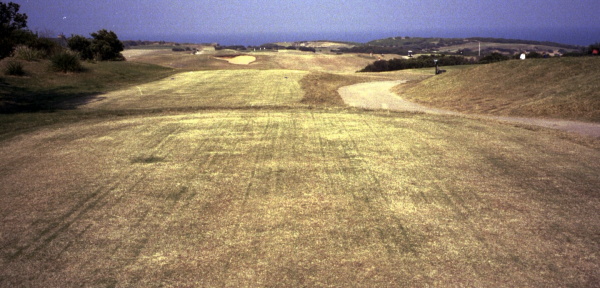
The view from the tee on #12 at New South Wales.
The ideal line is at the left side of the fairway; but a small miss going crosswind leaves the player in the deep left bunker, unable to clear the trench on his second shot. A drive too far right, however, is unlikely to make the bottom of the hill. From either the top of the hill, or halfway down it, the second shot will be very difficult, and again may not clear the trench. A good drive down the fairway, however, may tumble down the hill, pick up a lot of extra distance, and allow longer hitters to shoot for the green in two, but the narrowness of the exposed green and the trouble on either side requires a very controlled shot. As always, the green is fast and firm, and it slopes back-to-front.
The 12th at NSW shares many characteristics with #9 at Commonwealth, despite being nearly 400 yards longer and over different terrain. Both holes demand exacting shots and thoughtful strategizing from all, while neither is particularly long or frightening for the high marker. Finally, perhaps most importantly, both holes play completely differently with changing wind directions and pin positions. This is a wonderful contrast to so many modern American courses, where no matter what the conditions are, the proper play is a driver to the middle of the fairway and an iron shot aimed at the flag, regardless of the conditions and pin position. Holes such as #9 at Commonwealth and #12 at NSW play differently every day, and they remain challenging and interesting. One does not get bored of playing these holes and courses!
Overall, golf in Australia has simply been the beneficiary of a lot of great ideas. Through both intelligence and circumstances, those great ideas have generally been respected more in Australian golf course design and maintenance, than in their American counterparts. With Tom Doak’s work at Barnbougle Dunes in Tasmania, Mike Clayton’s solo work, their shared effort at St. Andrews Beach, and some other architects doing solid work around the country, the future of golf course design in Australia looks to have several very positive influences.
I’ve been asked once or twice about my surprises or disappointments in what I saw in Australia.
I found two major surprises. The first was how different all of the Sandbelt courses are from each other. Before I went, I knew about the bunkering, and that Aussie ‘look’, and I figured that the courses were all basically the same. They are not! A good observer would be able to look at a picture of one bunker and determine which Sandbelt course it came from. Big and bold? Royal Melbourne. Small with rough edges? Kingston Heath. There are many more differences! RM is wide and open, KH is narrow with ti-trees, Commonwealth is narrow with huge trees, and Victoria is a mix of styles. Of the courses I didn’t play, Yarra Yarra is narrow and treelined but the bunkering is different from Commonwealth, and Metro has more clean-cut lines than the others. Basically, all of the Sandbelt courses have their own characteristic look and feel, really surprisingly distinct from the others.
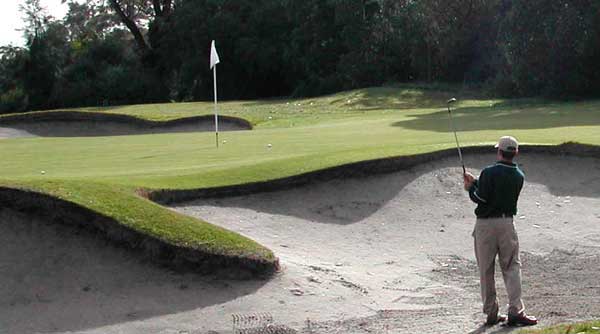
Beautiful Sandbelt bunkering on #14 at Commonwealth.
The other big surprise was the depth of good courses around Melbourne. I knew of the six or seven top Sandbelt clubs. But there are heaps of ‘second-tier’ courses that are really classy – Portsea, Peninsula, Spring Valley, Sorrento, Woodlands, and more. My GCA friends understood that I wouldn’t know about those places, and they were enthusiastic about showing me as many of them as they could. I’m glad they did, because there is so much more to see than I’d first realized!
There was also one characteristic of golf around Melbourne in which I was disappointed. Basically, so many of the courses had maybe 15 or 16 or 17 top holes…but not 18. Most of the classic courses had some inexplicable alterations, and even the new courses always seemed to have a strange hole or two.
Just for some examples, Victoria has had some awkward work by TWP, Commonwealth has tree issues and Hartley’s alterations, and even Kingston Heath has that bunker in the middle of #11 fairway. Sometimes, it’s not the club’s fault – Metropolitan, Commonwealth, and Southern all had land taken away by the government and were forced to replace holes.
The result is that on every course except Royal Melbourne, there are at least a couple of spots where one wonders, ‘Why did they do that? And why don’t they just fix it?’ I realize it’s that way at most courses, but on the Sandbelt courses in particular, the needs seem so obvious, and so easy. Victoria and Commonwealth should both be in the World Top 100. They have the resources to make changes, and it’s unfortunate and frustrating when those two clubs and others don’t use those resources to make the right changes.
If one looks at my rankings, the Sandbelt courses are almost exactly in order of how many alterations have been done: the more work has been done, the lower they are ranked. That wasn’t on purpose, but it’s not a coincidence either!
So, here are my rankings of the golf courses I played (hence the absence of Metropolitan, Royal Adelaide, Royal Melbourne East, and others), with some of my thoughts on each of the golf courses.
1. Royal Melbourne – West
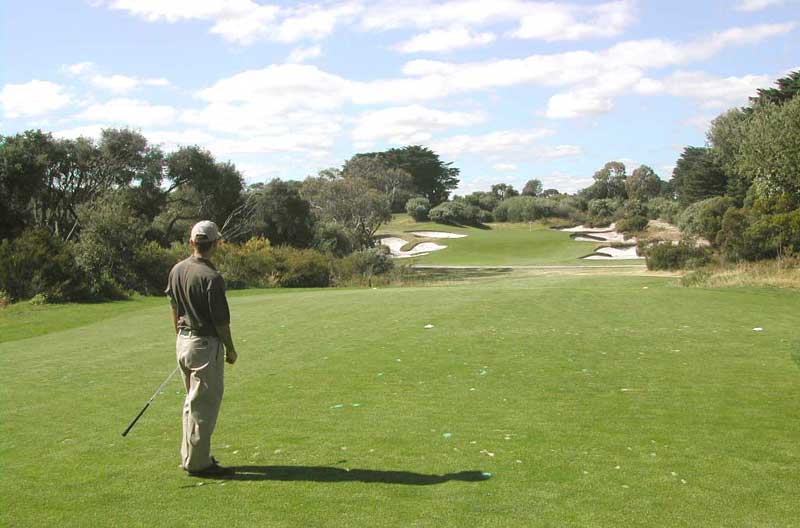
On my way to a par on #5 at Royal Melbourne West.
Ran Morrissett, in his Royal Melbourne course profile, contends that a great course must ultimately have great holes. This is so true on the West course! Holes 3, 4, 5, 6, 7, 10, 16, 17, and 18 (Heineken: 1, 2, 3, 4, 11, 12, n/a, 15, 16) are first class holes that have few rivals anywhere. The West was the first great Mackenzie course I played, and I found myself trying to grasp all the things I had read about: the scale of the course, the strategy built into each hole, the brilliant green sites, the beauty…there was so much to take in but it was all there. For me, RM lived up to all of the accolades I had heard and read.
2. New South Wales

Australia’s most photographed hole, #6 at New South Wales.
I think great courses are ones that fascinate players, and have them thinking about the holes for weeks and months to come, itching to come back. I chose NSW second over Kingston Heath because NSW tugged at me more in that way. I think it’s because NSW really gave me a sense of going on an adventure hike along the cliffs, with all of the anticipation and excitement that comes with it. The holes themselves embody that sense of adventure: the blind shots on 3 and especially 5; the sweep of the fairways on holes like 13, 15, and 16 that make one eagerly wonder just where they go; the dramatically perched greens on 3, 7, 11, 13, and 14; and the denouement of the 18th hole down a broad plain, finishing at the bottom of the hill beneath the clubhouse. NSW feels more ‘old style’ than any other course I’ve played, which I loved, but it’s that sense of adventure that really got to me.
3. Kingston Heath
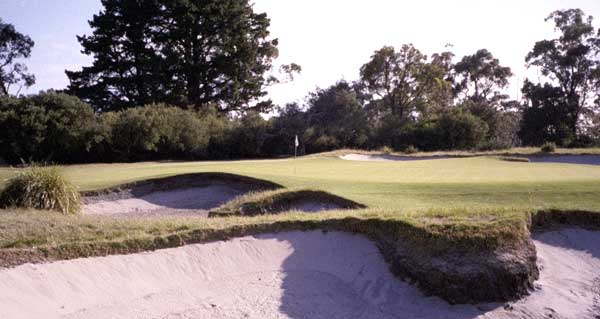
More Sandbelt bunkering, on #7 at Kingston Heath.
The Heath is first class in every way, and like Royal Melbourne, it has heaps of truly great holes: 3, 9, 10, 15, and 17, on my list. At RM or NSW, one stands on the tee of many holes instantly hooked. But at Kingston Heath, one’s appreciation of each hole builds more gradually with each step you walk from the tee, until one reaches the green and realizes the brilliance of the hole he has just played. I suppose I’ve put The Heath third because the site doesn’t quite compare to RM’s or NSW’s, so even though the quality of the holes is probably higher than at NSW, I didn’t feel quite the same thrill.
-. (Victoria)
I didn’t play Victoria. I just walked it a couple of times during the Australian Open, which is why I haven’t ranked it numerically. However, this is where I think it would belong. It’s a fantastic course, but I think two things keep it a bit below Kingston Heath. First, It just has a few less first class holes – maybe 4, 14, 15, and 16 to my eye – although that list might change if I played the course. Second, Victoria has a couple of things that don’t quite fit – some strange plantings, a bit of odd bunkering, a couple of out-of-place trees. It’s nothing tragic, but it’s enough to keep it below Kingston Heath. Still, a course I really enjoyed looking at, and I wish I’d had a chance to play.
4. Commonwealth
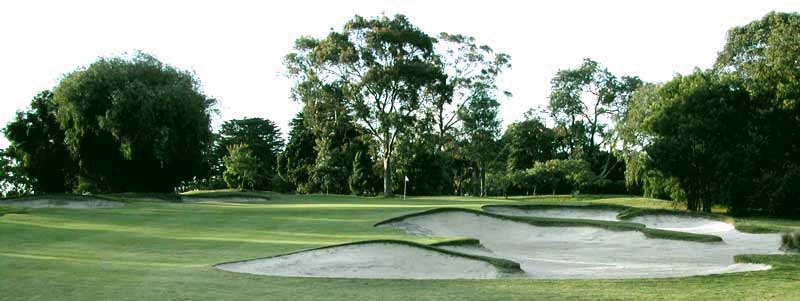
The par-4 #8 at Commonwealth.
Commonwealth has dropped sharply in national rankings over the last two decades. In the 1970’s, it was ranked the #2 course in Australia, and well inside the World Top 100. Now, it struggles to make some lists of Australia’s Top 20. The fact is that Commonwealth has had some unfortunate modifications and tree management over the years. Yet underneath all of the questionable choices lies the foundation of an absolutely wonderful golf course, of as high a quality as Kingston Heath. I feel it currently has two world-class holes – 9 and 16 – and it seems that #1 and maybe #7, two holes that don’t exist anymore, used to be in that same category. But there is so much brilliance lurking at Commonwealth, and so many holes that would be world-class if only….
One can just hope that this brilliance will be rediscovered before too long.
The End








